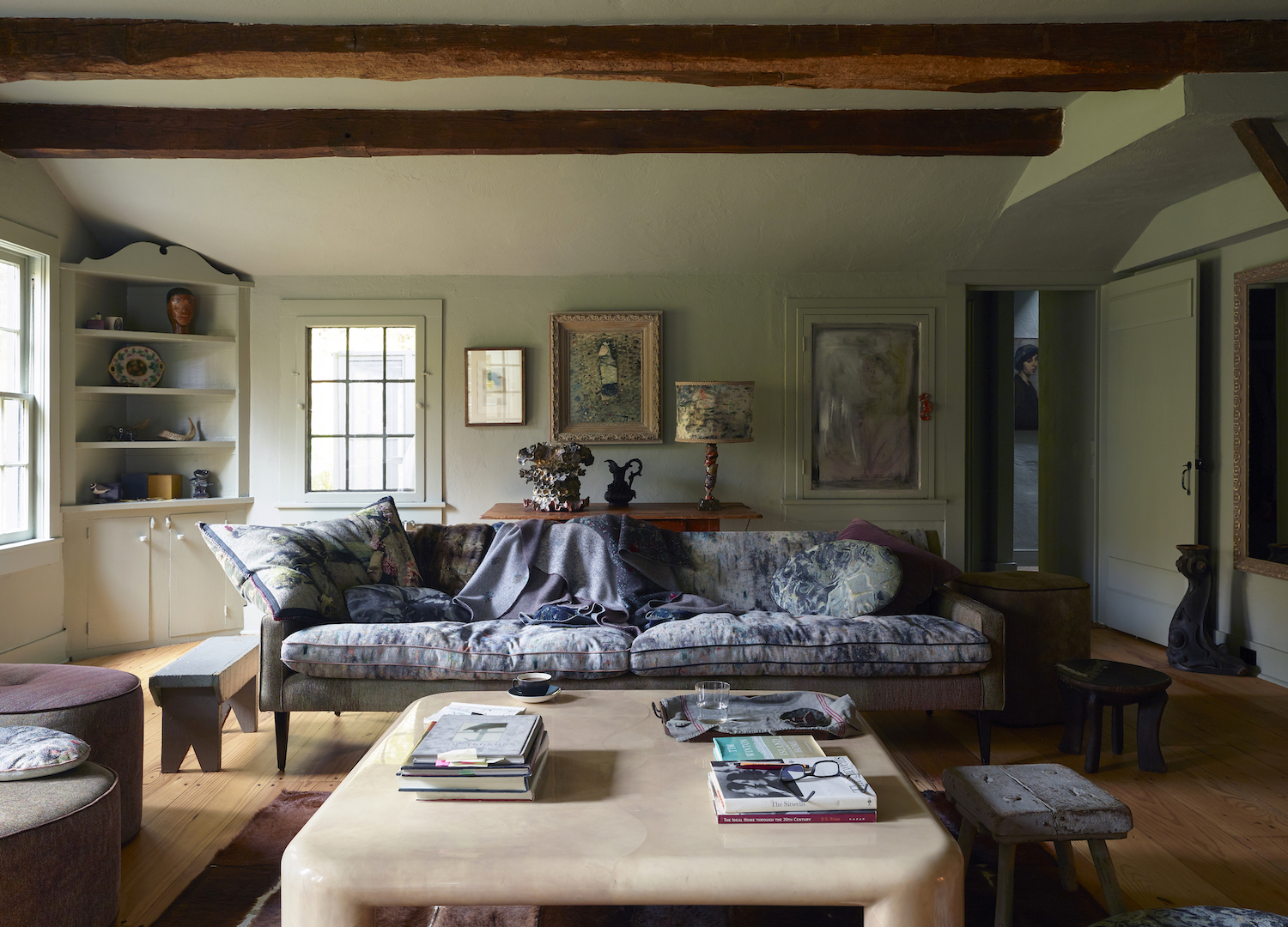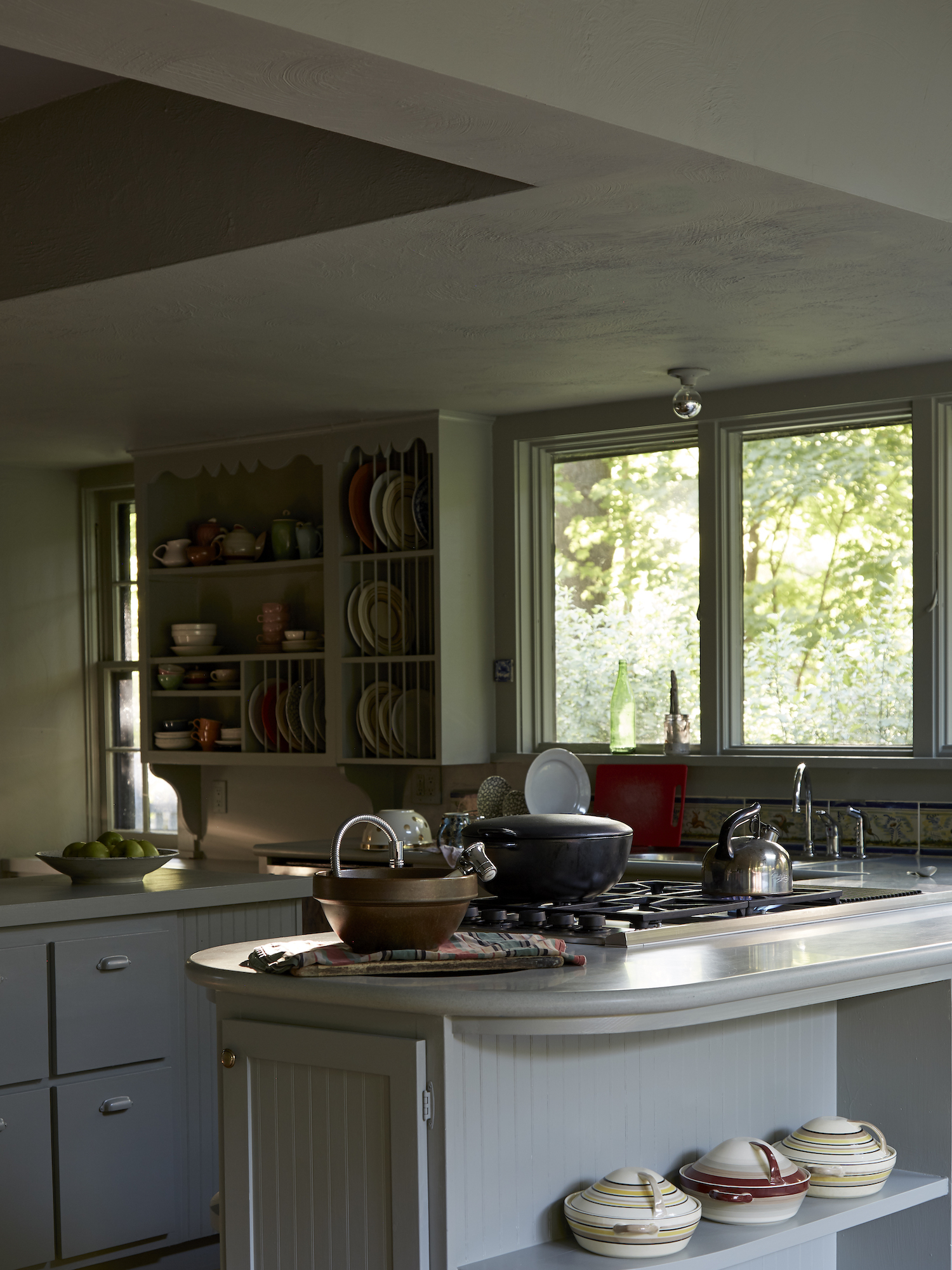Martyn Thompson is a creator of interior and exterior worlds. From a Sydney apartment to a house and garden in upstate New York, he conjures up magical spaces that touch the senses.
Martyn Thompson and I take tea (in hand-painted cups of his own design) in his Birtley Tower apartment in Sydney’s Elizabeth Bay. This seminal Sydney Art Deco building, by architect Emil Soderston, is an appropriate landing place for Martyn after 20 years in New York.

A range of jacquard fabrics of Martyn’s own design cover the couch, the ottomans and even the lampshade at the rear of the room. A variety of vintage stools speak to the rustic context, while the large 1970s table adds a note of deliberate contrast.
The notion that interiors can be an embodiment of personality is common, but here it finds deep and intense resonance with every item evoking an aspect of Martyn’s finely crafted aesthetic. Moody, off-beat tones, jacquard fabrics covering teardrop-shaped ottomans, and jewel-like Murano glass pendants combine with rough-hewn 19th-century tables and his latest rug designs for Tibet Sydney punctuate the space with rich, textural gestures.
The apartment showcases Martyn’s genius in conveying a sense of ‘meticulous ease’. He precisely considers placement, textures, proportions and form alongside light – always light – but the overall effect is of a certain relaxed, devil-may-care charm that feels anything but prescriptive.
But we are here to talk about Woodstock and his magical house and garden in the Catskills, where all of the above applies in the context of an American town famous for its unpretentious boho sensibility and famous music festival. A two-and-a-half-hour bus ride from New York, Martyn had visited friends there, and he acknowledges that the urge to buy was a stage of life thing. “I think there’s a point, generally for people in their 50s, where they desire to move to the country. So, I just followed that impetus. New York is fabulous but, in many ways, a tiring place to live,” he says.
The art of the still life, Martyn’s framed photographs are set against walls painted in his go-to shade – Farrow & Ball’s Pigeon.
The area appealed because it reminded him of where his mother grew up in Staffordshire in the English West Midlands, and the house, on the edge of town, was, at its original core, a 1920s artist’s house with several ill-advised add-ons throughout the ensuing decades. Undaunted, Martyn painted the exterior timber black, a common treatment in the area, while the interior was subjected to several unifying coats of his favourite paint, Farrow & Ball’s Pigeon. “It was a very stylistically inconsistent house, with windows from every decade, but also with a great deal of charm with different ceiling treatments – some lower with the wooden beams, another sporting a giant internal pitch,” he says.
But if two things captured his artistic imagination, it was the light and the garden. The block was a massive 12-thousand square metres, with wild woodland forming two-thirds and the house and garden the remainder. “It had once been a very established garden, a garden of note, and the original style was quite formal orchestrated around an impressive 17th-century Venetian rotunda with defined garden beds,” he says. Giant shrubs and mature trees edged the property with fencing necessary to keep wild deer from eating all the vegetation.

The placement of furniture and art responds to the differing nature of the rooms; for example, here, the original fireplace has an imposing presence. Martyn is an expert in mixing eras and here, a 1950s table and chair – with their fine form – are balanced by the massive sculptural vessels by Dove Hornbuck.
Struck by the drama of the changing seasons, Martyn observes how city and country life fundamentally differ. “The mortality cycle became very apparent to me but also the marvel of rebirth – something not so evident the city.”
The house is large (300 square metres), and he set about making good the electrics and plumbing – remedial work that made the house secure and liveable. His one major structural change was to add a generous fly-screened studio room that became a multi-purpose space allowing direct engagement with the garden for dining, painting, socialising and reading.
Furniture pieces were brought up from his loft in New York, chairs and sofas covered in jacquard fabric from his own ranges and framed flower portraits, again of his own creation, adorn the walls. “My work is all about aesthetics, and flowers are beautiful, wild and short-lived. There’s such a history of floral still life, it is such a timeless activity,” he says.
The garden became a collaborative effort with Maureen Drury, the mother of his ex-partner and good friend, Dove Hornbuckle. “I had a vision of a wild-looking English garden, and together we worked towards that. It was primarily a restorative activity,” he says.
Never one to stand still, and with a natural penchant for collaboration, Martyn is on the quest for new, daring creative allegiances to drive forward his ideas in Australia. “Nurturing relationships with local makers with manufacturing skills prepared to do small runs and collaborate on new ideas is very much the next stage for me.”
This feature originally appeared in est magazine issue 49: Force of Nature.
The sprawling garden in Woodstock pivots around a 17th-century Venetian rotunda.
One of the things Martyn loves is the shifting of the seasons and how the garden changes accordingly. One of the few structural changes was to build a screened room so that the garden could be enjoyed at all times of day while being protected from insects.

